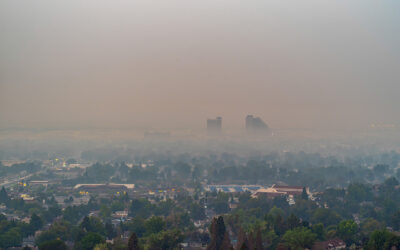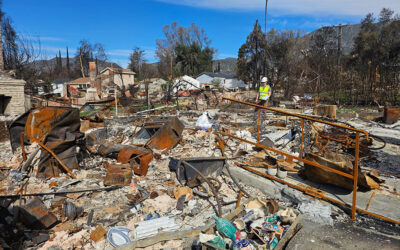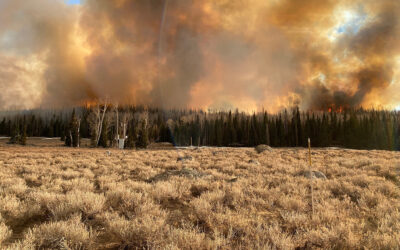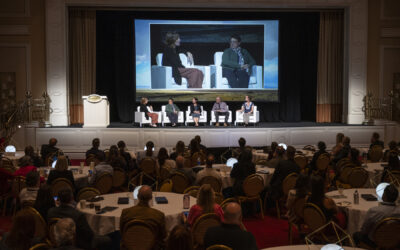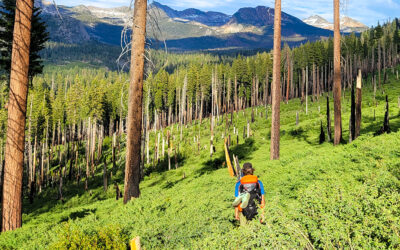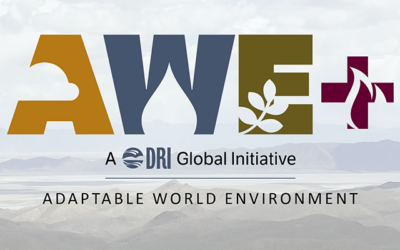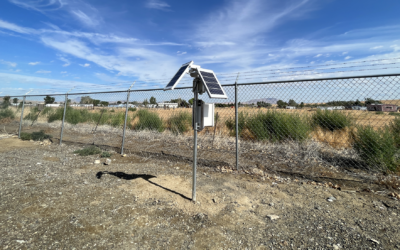The comprehensive research examined air quality in Reno, Nevada during 106 wildfires to illuminate the atmospheric and public health impacts of smoke. The research, published in April’s issue of Environmental Science: Atmospheres, measured air quality in Reno, Nevada over a 19 month period between 2017 and 2020 to capture both smoky and clear days.
What’s in the Burnt Remains of the LA Wildfires?
DRI scientists deployed to Los Angeles to collect ash, soil, and dust samples from burn zones in the hopes of illuminating the unique risks of wildland-urban fires. These urban fires presented a unique opportunity to understand how materials like plastics, metals, and even lithium batteries from electric cars can transform into environmental contaminants when they burn.
Floods, Droughts, Then Fires: Hydroclimate Whiplash is Speeding up Globally
DRI’s Christine Albano co-authored a new study that examines how a warming climate is creating an atmosphere more prone to extreme weather. This “hydroclimate whiplash” is evident in California’s recent weather, with winters filled with repeated atmospheric river storms driving the plant growth that the dry summers then parched, providing plentiful fuel for explosive wildfires.
What We Know About Wildfire Risk and Prevention
DRI scientists conduct a wide range of research on wildfire related topics to help policymakers, fire managers, and community members navigate challenges to public safety and health. In this Q&A, a selection of our scientists answer some of the most pressing questions about the environmental conditions that lead to the most devastating blazes and offer previews into some of their most relevant research.
DRI’s AWE+ Summit Tackles Wildfire Resilience and Recovery
DRI, one of our nation’s leading applied environmental research institutes, together with the DRI Foundation, this week held its inaugural AWE+ Summit -Wildfire Recovery and Resilience: Working Across Silos to Drive Solutions. The summit is a call-to-action for communities to implement measures that support resilience and human adaptability to devastating wildfire events. Nationally recognized scientific leaders discussed challenges, progress, and hope through actions that will lead to solutions.
Tracking the Restorative Effects of Good Fire
A few miles south of Yosemite’s famed Glacier Point, ringed by striking granite domes, lies the Illilouette Basin. This small stretch of the Sierra Nevada Mountains has become a sort of fire laboratory, a place where natural wildfires have been allowed to burn since 1972. In contrast with the long-supported program of fire suppression that has dominated American forests since the late 19th century, resulting in dense and unhealthy forests, the Illilouette Basin’s story is about the benefits that natural fire can bring to the landscape.
AWE+ 2024 Wildfire Recovery and Resilience: Working Across Silos to Drive Solutions
AWE+ an Adaptable World Environment August 21-22, 2024 – Las Vegas, NV For over six decades, DRI has tirelessly tackled scientific challenges related to global climate. DRI is unwavering in its commitment to continue this intensive research. But fortifying communities...
DRI to Host AWE+ Wildfire Summit
The AWE+ initiative will promote an Adaptable World Environment of strong, resilient communities in a climate shifting world. AWE+ 2024 – Wildfire Recovery and Resilience: Working Across Silos to Drive Solutions – is a global call-to-action for communities to implement measures that support resilience and human adaptability to devastating wildfire events. The event will be held at Encore Las Vegas from August 21-23, 2024.
DRI Researchers Partner with NDEP to Prepare Rural Nevada Communities for a Smokier Future
In 2021, DRI researchers partnered with the Nevada Division of Environmental Protection (NDEP) to address the gap in air quality monitoring. Led by Kristin VanderMolen, Ph.D., assistant research professor of atmospheric science, a new study details how the research team designed custom air quality sensors and information materials for rural Nevada counties.
Preparing for the Floods That Follow the Fires
A conversation with Guo Yu and Jeremy Giovando about their new research examining post-fire flood frequency. The study expands on previous frameworks to account for the compounding impacts of repeated wildfires on flood risk, using a southern California watershed as a case study.
